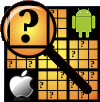Feedback and Questions
I've received a lot of interesting comments and questions from Sudoku fans over the last few years and this page is where I try to answer them. I'm also directing Str8ts feedback here. Please feel free to drop me a note on the side of the page. Or you can email me directly at andrew@str8ts.com.Post a Comment or Question here...
